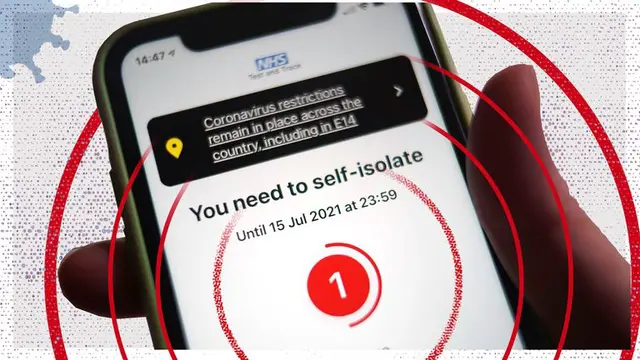There has been widespread criticism of the NHS COVID-19 Test and Trace app from business leaders, but new data analysis suggests it is doing what it is designed to do.
An increasing number of people are being forced to self-isolate after coming in contact with someone with
COVID
, largely driven by the app. **More than 500,000 people were pinged
**in the week ending 7 July - a 46% increase on the week before.
Businesses have complained
that this is causing severe staff shortages and unnecessary chaos, just as the remaining restrictions are lifted in England.
But Sky News analysis of data from NHS Test and Trace suggests that the app is largely effective, with contact tracing alerts keeping pace with rising infections.
While the government initially said it would
review the sensitivity of the app
, no changes are now expected and people are being urged to keep using it and self-isolate when told.
Professor Jon Crowcroft from the University of Cambridge points out that the app notifications are proportionate to the spread of the virus and the number of people using the app.
"There's nothing much wrong with the app - just people aren't socially distancing enough," he says.
There are fears that the effectiveness of Test and Trace is being undermined by people not checking into venues because they are worried about being told to self-isolate.
The lag in the data means we do not know how the
"pingdemic" over the last few weeks
has impacted app usage, but data up to the first week in July already points to a fall in the number of check-ins.
More than nine in 10 local authorities in England registered a decline in check-ins in the week ending 7 July compared with the week ending 26 May. This is the first available data after restrictions were eased on 17 May, when indoor hospitality resumed, but before a short-term surge in activity from the half-term holiday.
The drop was most pronounced in areas where infection rates are high, such as the North East and North West. Check-ins declined by more than a quarter over this period in Manchester, Wandsworth and Salford, which all have more than 500 daily cases per 100,000 people.
It is possible that the fall in numbers is because people are visiting public spaces less, not just because they are failing to check-in.
But analysis of Google's mobility index, which aggregates anonymised data from users' location history, suggests that activity has not dropped off.
Footfall at retail and recreation venues increased in all areas except one between mid-May and the first week in June. The data covers just over three-quarters of local authorities in England and Wales.
The NHS Test and Trace Contacts Insights Study, which is based on a relatively small sample of people in England, also suggests a drop in compliance.
The proportion of people that self-reported leaving isolation within the first 24 hours increased from 5% to 9% between the start of March and the first week in July.
Rising infection rates over the summer months could mean an increasing number of people are asked to self-isolate, potentially causing compliance and app usage to fall further.
Experts have warned that the app is a critical tool for controlling the pandemic, especially as other restrictions are lifted and the virus spreads ever more rapidly through the population.
Dr Simon Clarke, an associate professor at the University of Reading, said:"It is a great inconvenience to be asked to stay at home for 10 days, but it is much, much more damaging for people's health and the economy to have a rampant new wave of infections ballooning out of control.
"Self-isolation is one of the most effective tools we have to prevent spread."
**Follow the Daily podcast on **
Apple Podcasts,
Google Podcasts,
Spotify,
Spreaker
*The *
Data and Forensics
- team is a multi-skilled unit dedicated to providing transparent journalism from Sky News. We gather, analyse and visualise data to tell data-driven stories. We combine traditional reporting skills with advanced analysis of satellite images, social media and other open source information. Through multimedia storytelling we aim to better explain the world while also showing how our journalism is done.*
Why data journalism matters to Sky News
 简体中文
简体中文

